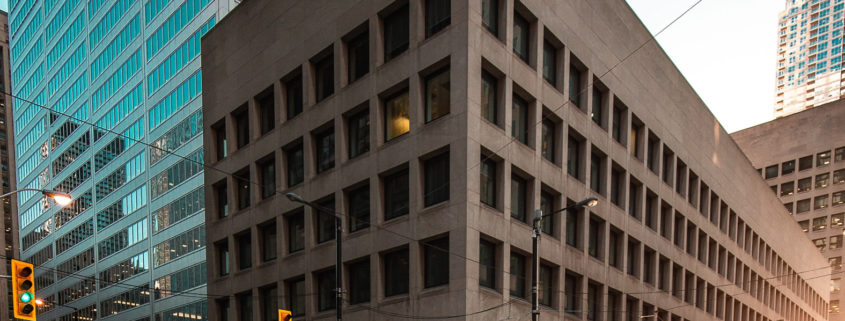Take a look at the top of commercial buildings throughout Akron, Canton and Youngstown (or all of northeast Ohio) and it’s plain to see: many of the roofs are flat or barely sloped.
Low-slope commercial roofs are a popular trend for building construction because they can offer several benefits, including lower cost, insulation and ease of repair.
But, nothing comes for free. This is especially true in Ohio, where roofs suffer year after year through scorching summer sun and freezing winter snows. Make no mistake, these extreme fluctuations in weather are especially taxing on a flat roof.
So, before you look at constructing your own new building or renovating your existing one, use this guide to fully understand some of the common problems associated with a low-slope roofing system.
What Is a Low-Slope Commercial Roof?
You’ve seen them before—the flat roofs on large industrial or commercial buildings (even apartments!).
Technically, any roof with a slope of 3:12 (or about 2%) is considered a low-slope roof. And, while building materials can vary, these roofs often have an asphalt built-up covering.
Most built-up roofs consist of multiple layers made up of a series of felt and asphalt sheets. The top layer is then covered in gravel or reflective metal to protect from ultraviolet rays.
Newer roofs may use alternative materials like single-ply PVC membranes or a modified bitumen covering. (These coverings have one or more layers of polymer-modified asphalt sheets.) Systems like this can be mechanically fastened or directly fastened to the roof.
Difference Between Low-Slope and Pitched Roofs
As opposed to low-slope or flat roofs, a steep slope (or high pitched roof) offers a greater rise along the roof’s surface.
Pitched roofs are most abundant in traditional housing where steep roofs help water and snow to flow freely into gutters. But, steep slope roofs aren’t just limited to single-family houses. Some commercial buildings also utilize traditional steep-sloped roofs, though they are not nearly as common because of the larger scale of most commercial properties.
Where low-slope roofs use single layers of material, a pitched roof will most often use an interlocking layer of shingles or tiles as a covering.
Pitched roofs also require flashing around valleys or along the drip edge to connect with the roof’s membrane and prevent leaks.
Problems With Low-Slope Roofs
While low-slope commercial roofs offer some advantages, they also come with issues, especially with the minute-by-minute weather changes Ohio has to offer.
By far, the most insidious problems are those caused by water pooling on the surface. This not only causes leaks, but can also erode the structure that is holding up the roof itself.
And, while regular preventative maintenance can help alleviate some of these issues, there’s only so much patching and repairing a roof can take. Punctures and improper repairs can take their toll and leave building owners no other choice that to replace their roof.
Let’s take a look at some of the most common low-slope commercial roof problems.
Leaks
It’s every building owner’s worst nightmare. Once water crawls its way into a building, it can damage inventory and contents. This doesn’t only mean roof repairs…it also means replacement costs for other damages.
Roof leaks are usually the result of improper installation or failure of the roofing material. Especially when you are dealing with a single-layer low-slope roof, leaks can be much more likely.
Freeze-Thaw Cycle
While a commercial roof should last about 10 to 20 years with proper maintenance, extreme temperature fluctuations wreak havoc on any roofing surface.
Low-slope roofs are more likely to fall victim to the freeze-thaw cycle. With the freeze-thaw cycle, the roof material expands in heat and contracts with cold, and this constant movement puts strain on seams and adhesions.
Stress on the roof from freeze-thaw is (obviously) compounded by poor installation or lack of maintenance. Since damage usually doesn’t happen overnight, proper maintenance can keep a small issue from becoming a major one!
Incompatible Materials
It’s not just what a roof is made of that matters, but also how it reacts to what’s put on it.
For instance, grease from restaurants (blown through vents and onto the roof) can erode the surface’s membrane and cause cracks.
Or, an inexperienced repairman may use incompatible materials for repairs (which can negate any potential roofing warranty you have in place). For example, wet/dry roofing cement can eat through EPDM or TPO roofs because the materials create a chemical reaction.
That’s why it’s important to use a qualified commercial roofing repair team that has experience with your particular type of roofing system.
Pooling
While sloped roofs easily slough away rain and snow, a low-slope roof may have uneven flat spots in which puddles form.
(It’s recommended that water or snow be removed from a roof’s surface at least 48 hours after it accumulates.)
If a roof is improperly installed or maintained, a low-slope roof may have flat spots or divots where water cannot drain. This water then weighs heavily on seams and can create leaks.
Your Trusted Commercial Roofing Resource
While it’s important to have an idea of what you want before you call, only a trained commercial roofing professional can know for sure what best fits your building’s needs.
Whether looking for low-slope commercial roof repair (due to common flat roof issues) or full replacement, our team is ready to help guide you toward the best decision possible.
If you’ve read this guide and still have questions (or are ready to take action), feel free to contact us. We are ready to help with all your commercial roofing needs.





